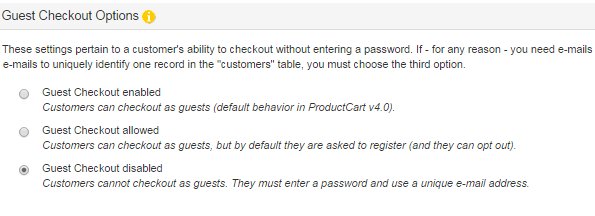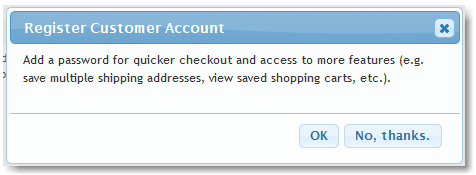Checkout Options
Settings > Store Settings > Checkout Options
Referrer Drop-Down Menu
You have the ability to ask a customer to fill out a “Referrer” field when checking out or registering on the store for the first time. This can help you determine where your customers are coming from. Of course, you may also use this field for other purposes. ProductCart can generate sales reports based on this option (e.g. show me all sales referred by Google in the last 30 days).
The referrer field has the following characteristics:
- The selectable options are displayed with a drop-down menu. It is shown below the billing information on the registration and/or checkout page, depending on how the feature is configured, with the description entered on this page under Field Description.
- The field is only shown the first time a customer visits the store. Repeat customers are not shown this field.
- The field can be set to be required or not.
To add entries to the drop-down menu, enter a description in the Available Selections field, and click on the Add New button. The page will refresh and the new menu item will be listed.
After adding the menu items that you would like to display, you can set the order in which they appear in the drop-down menu by entering an order number in the appropriate field. Click on the Update Order button to confirm the new order setting.
If you no longer wish to show a certain entry in the drop-down, it is recommended that you render it inactive rather than deleting it. This way you can still obtain reports based on that entry.
Guest checkout options
These options pertain to a customer's ability to checkout without entering a password (read about
Guest vs. Registered Customers ). If - for any reason - you need e-mails to uniquely identify one record in the “customers” table, you must choose the third option (Guest Checkout Disabled).

Guest checkout enabled
Customers can checkout as guests (default behavior). In this scenario, customers can opt to checkout without entering a password. The same customer can checkout on the same store, using the same e-mail address, multiple times, and multiple 'guest' profiles will be created.If the customer at any point decides to convert to a registered account, ProductCart will prompt him/her to consolidate into that account the other 'guest profiles' that exist in the database (accounts that use the same e-mail address).
When customers check out as a guest, they cannot log into their account using a password, since a password does not exist. What they can do is review information for an order that they have placed (e.g. to review the order status) by logging in with their e-mail address and the order “code” that was included in the e-mail notifications sent by ProductCart when the order was placed. The Order Code can also be found in the ProductCart Control Panel, on the order details page.
Guest Checkout allowed
Customers can checkout as guests, but by default they are asked to register (and they can opt out). The difference between enabled and allowed is that with this second configuration the customer is prompted to enter a password during checkout. The customer can opt out and not do so.When the customer gets to the Payment & Other Information panel, he/she is presented with the password fields, as shown in the screen shot below.

If the customer clicks on the Continue button without entering a password, the following modal window is shown, asking the customer to consider saving a password. As you can see, the customer can opt out by clicking on the No thanks button.

In other words, unlike with Guest Checkout Enabled, a password is initially required and the customer is prompted to enter it with a friendly “alert” message. The alert message, however, contains a button that allows the customer to proceed without saving a password. So the customer can still checkout as a guest, but might decide to register an account, especially if you customize the alert message and provide information on why registering an account is a good idea on your store (e.g. you use the Reward Points system and “guests” cannot take advantage of Reward Points).
Since you are actively prompting customers to register, this approach may lead to more registered customers than guests, while still allowing those that absolutely do not want to save a password to continue without doing so.
Guest checkout disabled
Customers cannot checkout as guests.- A unique e-mail address must be used.
The system validates the e-mail address and prompt the customer to enter a different e-mail address or log into his/her account if the same address already exists in the database. - A password is required.
The system will not allow a customer to place an order unless a password has been entered.
Technical Notes
- This setting is saved to includes/settings.asp
- The name of the constant is scGuestCheckoutOpt
- The values are:
- 0 = Guest Checkout Enabled
- 1 = Guest Checkout Allowed
- 2 = Guest Checkout Disabled
Terms & Conditions Agreement
You can ask your customers to agree to your “Terms & Conditions” before they can checkout. They are asked to do so when placing the first order (or registering with the store), and not again (a cookie is saved to the customer’s computer).
When shown, this field is always required. The text of the agreement is shown through a scrollable, read-only text area. A check-box allows customers to agree to the terms.
Newsletter settings
ProductCart includes a Newsletter Wizard that allows you to send select customers email messages about offers, new products, etc. We strongly discourage you to use this feature as a “spam” tool (spamming is also illegal in many states & countries). The Newsletter Settings allow you to have customers opt in to receive messages from you (e.g. product updates, offers, etc.). Newsletters and other messages should not be sent to customers that did not opt to receive them. The Newsletter Settings are as follows:
- Field Description. This is the text that is displayed next to the radio button that allows customers to opt to receive messages from you. For example, the field description could say something like: “Sign up for our newsletter to receive a weekly update on new products and other offers.”
- Show this field. Turns the feature on and off.
- Show on …. The field description and corresponding Yes/No radio button is shown below the billing information on the registration and/or checkout page.
Date fields and blackout dates
You can ask customers to specify a date & time to be associated with an order. This is especially useful for stores that sell products or services that must be delivered at a specific time (e.g. catering business). A pop-up calendar makes it easy for customers to select a date.
Both for the date and time fields you can set whether or not either field should be shown, and whether they should be required. You can also enforce an order delivery date & time that is at least 24 hours in the future.
To ensure that dates are entered in the correct format, the Date input field is a read-only field. Customers will use the pop-up calendar to select a date.
Associated with this feature is the ability to set dates for which the order cannot be delivered (or the service cannot be provided). In ProductCart, these are referred to as Blackout Dates. You can set Blackout Dates by selecting Settings > Manage Blackout Dates. For example, a catering company may not provide its services on certain holidays. Therefore, customers should not be able to select those dates when placing an order.
When customers checkout on a store that is using this feature, a link next to the Delivery Date field allows customers to see a list of blackout dates. The information is shown in a separate window.
If a customer selects a delivery date without realizing that it is a blackout date, a message is shown and the customer is prompted to select another date. Customers will not be able to checkout unless they choose an acceptable date.
Limit delivery area by zip code
ProductCart features an option to limit the store’s delivery area by postal code. When this feature is enabled, customers will only have the option of shipping/delivering items to a list of accepted postal codes.
This feature works well for stores whose services are only available to customers located in a specific geographic area. For example, an online grocery store may only accept orders that are shipped within a specific urban area.
The feature affects all orders and cannot be associated with a particular product or a particular shipping option. Note that the feature will not affect the ability for customers to register with the store, but rather only their ability to place an order. In other words, the billing address is not geographically limited, only the shipping address is. If the shipping and billing address are the same and the billing address falls outside of the delivery area, the customer will be required to provide a separate shipping address.
Customer IP address alert
ProductCart saves the Customer's IP address during checkout. You can alert customers that you are saving their IP address by showing them a corresponding message at the top of the payment page. Some online stores like to do so in an effort to reduce fraudulent orders by showing a commitment to try to track down or report illegal activity to the authorities.
In the United States, you can report Internet crime (e.g. a fraudulent transaction on your store where somebody clearly stole someone else’s identity and placed an order using that person’s credit card) using http://www.ic3.gov/.

